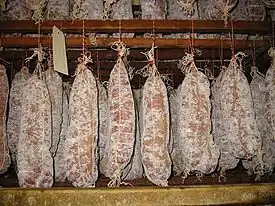Fermented sausage
Fermented sausage, or dry sausage, is a type of sausage that is created by salting chopped or ground meat to remove moisture, while allowing beneficial bacteria to break down sugars into flavorful molecules. Bacteria, including Lactobacillus species and Leuconostoc species, break down these sugars to produce lactic acid, which not only affects the flavor of the sausage, but also lowers the pH from 6.0 to 4.5–5.0, preventing the growth of bacteria that could spoil the sausage. These effects are magnified during the drying process, as the salt and acidity are concentrated as moisture is extracted.
The ingredients found in a fermented sausage include meat, fat, bacterial culture, salt, spices, sugar and nitrite. Nitrite is commonly added to fermented sausages to speed up the curing of meat and also impart an attractive colour while having no effect on the growth of the Clostridium botulinum bacteria which causes botulism.[1][2] Some traditional and artisanal producers avoid nitrites. Sugar is added to aid the bacterial production of lactic acid during the 18-hour to three-day fermentation process; the fermentation time depends on the temperature at which the sausage is stored: the lower the temperature, the longer the required fermentation period. A white mold and yeast sometimes adheres to the outside of the sausage during the drying process. This mold adds to the flavor of the sausage and aids in preventing harmful bacteria from attaching to the sausage.[3]
The two main types of fermented sausage are the dry, salted, spiced sausages found in warmer climates and fermented semidry sausages found in cooler, more humid climates. Since the dry sausages of the Mediterranean, in countries such as Italy, Spain, and Portugal contain 25–35% water and more than 4% salt, they may be stored at room temperature. The sausages of northern Europe usually contain less salt (around 3%) and 40–50% water, and as such do not dry well in the humid climate of countries such as Germany.
See also
Notes
- Wilson, Bee (2018-03-01). "Yes, bacon really is killing us". The Guardian. London. ISSN 0261-3077. Archived from the original on 2021-02-10. Retrieved 2021-02-14.
In trade journals of the 1960s, the firms who sold nitrite powders to ham-makers spoke quite openly about how the main advantage was to increase profit margins by speeding up production.
- Doward, Jamie (2019-03-23). "Revealed: no need to add cancer-risk nitrites to ham". The Observer. London. Archived from the original on 2021-01-26. Retrieved 2021-02-14.
The results show that there is no change in levels of inoculated C. botulinum over the curing process, which implies that the action of nitrite during curing is not toxic to C. botulinum spores at levels of 150ppm [parts per million] ingoing nitrite and below.
- McGee, 176.
References
- McGee, Harold. On Food and Cooking: The Science and Lore of the Kitchen. New York: Simon and Schuster, 2004. ISBN 0-684-80001-2.
